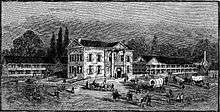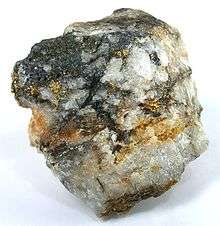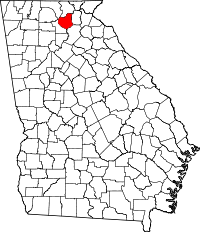Dahlonega, Georgia
| Dahlonega, Georgia, USA | |
|---|---|
| City | |
|
Historic Lumpkin County Courthouse, which now houses the Dahlonega Gold Museum Historic Site | |
| Nickname(s): Gold City | |
 Location in Lumpkin County and the state of Georgia | |
| Coordinates: 34°32′N 83°59′W / 34.533°N 83.983°WCoordinates: 34°32′N 83°59′W / 34.533°N 83.983°W | |
| Country | United States |
| State | Georgia |
| County | Lumpkin |
| Government | |
| • Mayor | Gary McCullough |
| • City Manager | Bill Schmid |
| Area | |
| • Total | 6.4 sq mi (16.6 km2) |
| • Land | 6.4 sq mi (16.6 km2) |
| • Water | 0.0 sq mi (0 km2) |
| Elevation | 1,450 ft (442 m) |
| Population (2010) | |
| • Total | 5,242 |
| • Estimate (2016)[1] | 6,437 |
| • Density | 569/sq mi (219.5/km2) |
| Time zone | EST (UTC-5) |
| • Summer (DST) | EDT (UTC-4) |
| ZIP codes | 30533, 30597 |
| Area code(s) | 706 |
| FIPS code | 13-21240[2] |
| GNIS feature ID | 0355420[3] |
| Website | http://dahlonega-ga.gov/ |
| http://dahlonega-ga.gov/ | |

_(16537558623).jpg)
The city of Dahlonega is the county seat of Lumpkin County, Georgia, United States.[4] As of the 2010 census, the city had a population of 5,242.[5]
Dahlonega is located at the north end of Georgia 400, which connects Atlanta to many suburbs to the north. It is consistently named as a best place to retire by many different publications.[6]
In 1828 Dahlonega was the site of the first major gold rush in the United States. The Dahlonega Gold Museum Historic Site stands in the middle of the town square, housed in the 1836 Lumpkin County Courthouse. From its steps in 1849, Dahlonega Mint assayor Dr. M. F. Stephenson tried to persuade miners to stay in Dahlonega instead of joining the California Gold Rush, saying, "There's millions in it," famously misquoted as "There's gold in them thar hills."[7][8]
Dahlonega is home to a campus of the University of North Georgia.
History
Gold rush
In 1829, Dahlonega became the site of the second significant gold rush in the US and became a boom town of the Georgia Gold Rush.
Native Americans
Dahlonega was home to many Creeks and Cherokees. There are a few Creek and Cherokee descendants in Dahlonega today, though not in distinct communities but scattered throughout the area. Most of the descendants are mixed Cherokee. Names like Corn, Davis, Chambers, Dover, Chattin, and Bird are of Cherokee blood. Surnames like Thrasher are of Creek blood. Though not afforded state or federal recognition, these families still hold onto who they are as Cherokee and Creek people. The Cherokee called the area ᏓᎶᏂᎨ or Da-lo-ni-ge, which means yellow (from the Dikaneisdi (Word List) of the Cherokee Language); George Featherstonhough, an English geologist who visited the town in 1837, observed that the courthouse, designed by Ephriam Clayton,[9] was built upon a broad expanse of hornblende slate "and that the soil of the public square was impregnated with small specks of gold."[10] The courthouse building was paid for in part with gold bullion, using bricks likely made in Lumpkin County (although possibly transported from Augusta), with both its foundation stone and timber obtained locally.[9]
The spelling of the Cherokee word Da-lo-ni-ge-i was disputed by early correspondents, with Featherstonhough, for example, calling it "Tahlonekay".[11]
Since 1977, the state recognized tribe has been known as the Georgia Tribe of Eastern Cherokee.[12]
Illegal mining
Numerous gold mines were illegally developed in the area. Miners, entering illegally into the Cherokee Nation lands, came into conflict with the Cherokee, whose territory they had trespassed. The Cherokee lands were defined by the treaty between the Federal Government and the Cherokee Nation in the Treaty of Washington 1819. The miners raised political pressure against the Cherokee because they wanted to get the gold. The Federal Government forced the Native Americans west of the Mississippi River to Oklahoma on the Trail of Tears during Indian Removal. Dahlonega was founded two years before the Treaty of New Echota 1835, which made its founding a violation of the Treaty of Washington of 1819.[13][14]
Naming the city

In 1833 the city was named Talonega by the Georgia General Assembly on December 21, 1833.[16] The name was changed from Talonega by the Georgia General Assembly on December 25, 1837 to Dahlonega,[16] from the Cherokee-language word Dalonige, meaning "yellow" or "gold".[15][17] The city is just east of Auraria; each claims to be the site of the first discovery of gold. Senator John Calhoun of South Carolina (7th Vice President of the United States) owned the Calhoun Mine, just south of the city square.
Coin minting

The United States Mint built a branch mint here, which it operated from 1838–1861. The Dahlonega Mint, like the one established in 1838 in Charlotte, North Carolina, only minted gold coins, in denominations of $1.00, $2.50 (quarter eagle), $3.00 (1854 only) and $5.00 (half eagle). It was cost effective in consideration of the economics, time, and risk of shipping gold to the main mint in Philadelphia, Pennsylvania. The Dahlonega Mint was a small operation, usually accounting for only a small fraction of the gold coinage minted annually in the US.
The government decided against re-opening the facility after the Civil War. By then, the U.S. government had established a mint in San Francisco, California. Given the large amount of gold discovered in California from the late 1840s on, that one handled the national needs of gold minting.
As a result, surviving Dahlonega coinage is today highly prized in American numismatics. The mint building burned in 1878. North Georgia College built Price Memorial Hall on its foundation.[18] The building has a gold-leaf steeple to refer to the history of the site.
Wine and tourism
In recent years, Dahlonega and Lumpkin County have been recognized as "the heart of the North Georgia Wine Country". The county features multiple vineyards and five licensed wineries that attract many tourists.
The historic Dahlonega Square is also a popular destination, with gift shops, restaurants, art galleries and studios, and wine tasting rooms. In 2015, Senator Steve Gooch introduced Georgia Senate Resolution 125 officially recognizing Lumpkin County as the Wine Tasting Room Capital of Georgia.
The city's local festivals draw many visitors. "Bear on the Square", an annual three-day festival held the third weekend in April, marks the day that a black bear wandered onto the square. It features bluegrass and old-time music. "Gold Rush Days", an annual two-day event the third weekend in October, attracts over 200,000 people.[19]
Dahlonega is home to the Holly Theatre.
Historical marker
Located at 384 Mountain Drive, WPA Historical Marker 19 B-7 explains:
This court house, built in 1836, replaced the small structure used since the establishment of Lumpkin County in 1832. The town was named Dahlonega in October, 1833, for the Cherokee word Talonega meaning "golden."
From its steps in 1849, Dr. M.F. Stephenson, assayer [sic] at the Mint, attempted to dissuade Georgia miners from leaving to join the California Gold Rush. His oration gave rise to the sayings: "There's millions in it," and "Thar's gold in them thar hills."[20]
Geography
Dahlonega is located at 34°32′N 83°59′W / 34.533°N 83.983°W (34.5305, −83.9847).[21]
According to the United States Census Bureau, the city has a total area of 6.4 square miles (17 km2), all land.
Demographics
| Historical population | |||
|---|---|---|---|
| Census | Pop. | %± | |
| 1840 | 671 | — | |
| 1850 | 735 | 9.5% | |
| 1870 | 471 | — | |
| 1880 | 602 | 27.8% | |
| 1890 | 896 | 48.8% | |
| 1900 | 1,255 | 40.1% | |
| 1910 | 829 | −33.9% | |
| 1920 | 690 | −16.8% | |
| 1930 | 905 | 31.2% | |
| 1940 | 1,294 | 43.0% | |
| 1950 | 2,152 | 66.3% | |
| 1960 | 2,604 | 21.0% | |
| 1970 | 2,658 | 2.1% | |
| 1980 | 2,844 | 7.0% | |
| 1990 | 3,086 | 8.5% | |
| 2000 | 3,638 | 17.9% | |
| 2010 | 5,242 | 44.1% | |
| Est. 2016 | 6,437 | [1] | 22.8% |
As of the census[2] of 2000, there were 3,638 people, 1,060 households, and 568 families residing in the city. The population density was 568.1 people per square mile (219.5/km2). There were 1,181 housing units at an average density of 184.4 per square mile (71.2/km2). The racial makeup of the city was 89.94% White, 4.95% African American, 0.44% Native American, 0.71% Asian, 0.11% Pacific Islander, 2.56% from other races, and 1.29% from two or more races. Hispanic or Latino of any race were 6.57% of the population.
There were 1,060 households out of which 23.4% had children under the age of 18 living with them, 41.1% were married couples living together, 9.3% had a female householder with no husband present, and 46.4% were non-families. 31.5% of all households were made up of individuals and 10.9% had someone living alone who was 65 years of age or older. The average household size was 2.31 and the average family size was 2.96.
In the city, the population was spread out with 13.5% under the age of 18, 42.9% from 18 to 24, 19.0% from 25 to 44, 13.2% from 45 to 64, and 11.4% who were 65 years of age or older. The median age was 22 years. For every 100 females there were 73.6 males. For every 100 females age 18 and over, there were 69.3 males.
The median income for a household in the city was $28,636, and the median income for a family was $44,904. Males had a median income of $30,500 versus $22,917 for females. The per capita income for the city was $16,572. About 11.4% of families and 24.4% of the population were below the poverty line, including 19.4% of those under age 18 and 13.8% of those age 65 or over.
Education
Lumpkin County School District
The Lumpkin County School District holds pre-school to grade twelve, and consists of three elementary schools, a middle school, and a high school.[23] The district has 215 full-time teachers and over 3,511 students.[24]
- Lumpkin County Elementary School
- Long Branch Elementary School
- Blackburn Elementary School
- Lumpkin County Middle School
- Lumpkin County High School
Higher education
Dahlonega is home to University of North Georgia (formerly named North Georgia College and State University), North Georgia College and North Georgia Agricultural College, the Senior Military College of Georgia and the second oldest public university in the State of Georgia. The University of North Georgia is one of six senior military colleges (along with the Public Campuses of Texas A&M University, the Citadel, the Virginia Military Institute and Virginia Tech, and the Private Campus of Norwich University). The campus' administration building, Price Memorial Hall, is topped with a spire covered with gold leaf from the town. The rotunda dome of the Georgia State Capitol in Atlanta is also covered with Dahlonega gold.
Other educational facilities
- Wahsega 4-H Center, an environmental education center and summer camp owned by the University of Georgia and administered through the UGA Cooperative Extension Service Georgia 4-H program
- Camp Glisson, a year-round retreat camp owned by the North Georgia Conference of the United Methodist Church
Famous residents
- John Bell - Widespread Panic lead singer and guitarist
- Zac Brown - Zac Brown Band's lead singer
- Sara Christian, NASCAR's first female driver
- Dallas Kinney - Pulitzer Prize-winning photographer
- Amy Ray - Indigo Girls singer and songwriter
- Timothy Lynch, USA World Cup soccer team
International relations
Twin towns – sister cities
Dahlonega is twinned with:
References
- 1 2 "Population and Housing Unit Estimates". Retrieved June 9, 2017.
- 1 2 "American FactFinder". United States Census Bureau. Archived from the original on 11 September 2013. Retrieved 2008-01-31.
- ↑ "US Board on Geographic Names". United States Geological Survey. 2007-10-25. Retrieved 2008-01-31.
- ↑ "Find a County". National Association of Counties. Archived from the original on 31 May 2011. Retrieved 2011-06-07.
- ↑ http://quickfacts.census.gov/qfd/states/13/1321240.html
- ↑ http://realestatescorecard.com/area-information/northern-georgia/dahlonega
- ↑ http://www.lumpkinhistory.org/history/millions
- ↑ http://dlg.galileo.usg.edu/dahlonega/history.php
- 1 2 Head, Sylvia Gailey; Etheridge, Elizabeth W. (2000). The Neighborhood Mint: Dahlonega in the Age of Jackson. Gold Rush Gallery, Alpharetta, Georgia. ISBN 0967976901.
- ↑ Featherstonhough, George W. A Canoe Voyage Up the Minnay Sotor, 2 vols., London, 1847. Cited by Head, Sylvia and Etheridge, Elizabeth W.: The Neighborhood Mint: Dahlonega in the Age of Jackson, Gold Rush Gallery, Alpharetta, Georgia, 1986. (Quotation from Head and Etheridge.)
- ↑ Coulter, E. Merton. Auraria, Athens, Georgia, 1956, pp. 99-100. (Cited by Head and Etheridge.)
- ↑ Silavent, Joshua (February 21, 2016). "Fight over Cherokee blood line could be nearing resolution". Gainesville Times. Retrieved 18 February 2017.
- ↑ James Loewen, (1996).
- ↑ http://georgiainfo.galileo.usg.edu/washing5.htm
- 1 2 "English/Cherokee Dictionary". Retrieved 17 April 2012.(registration required)
- 1 2 Acts passed by the General Assembly, by J. Johnston, 1838
- ↑ "The Names Stayed". Calhoun Times and Gordon County News. August 29, 1990. p. 64. Retrieved 29 April 2015.
- ↑ Price Memorial Building State Historical Marker (accessed 27 October 2006)
- ↑ Dahlonega Jaycees
- ↑ Georgia Historical Markers (accessed 27 October 2006)
- ↑ "US Gazetteer files: 2010, 2000, and 1990". United States Census Bureau. 2011-02-12. Retrieved 2011-04-23.
- ↑ "Census of Population and Housing". Census.gov. Archived from the original on 12 May 2015. Retrieved June 4, 2015.
- ↑ Georgia Board of Education, Retrieved 23 June 2010.
- ↑ School Stats, Retrieved 23 June 2010.
- ↑ "Myślenice - Miasta partnerskie" [Myślenice - Partnership Cities] (in Polish). Archived from the original on 2 May 2013. Retrieved 4 August 2013.
"Such Excitement You Never Saw": Gold Mining in Nineteenth-Century Georgia David Williams The Georgia Historical Quarterly, Vol. 76, No. 3 (Fall 1992), pp. 695–707 Published by: Georgia Historical Society Article Stable URL: http://www.jstor.org/stable/40582597
Further reading
- "Gold-Mining in Georgia." Harper's New Monthly Magazine 59, Issue 352 (September 1879): 517–519. Available here
- I Remember Dahlonega: Memories of Growing Up in Lumpkin County, by Anne Dismukes Amerson (Chestatee Publishing: 1993)
- Williams, David (1993). The Georgia Gold Rush: Twenty-Niners, Cherokees, and Gold Fever. Columbia, South Carolina: University of South Carolina Press. ISBN 1-57003-052-9.
External links
| Wikivoyage has a travel guide for Dahlonega. |
- City of Dahlonega Website
- Dahlonega Georgia Merchants Association
- Dahlonega Nugget Newspaper
- "Thar's Gold in Them Thar Hills": Gold and Gold Mining in Georgia, 1830s–1940s
- The Bear On the Square Mountain Festival
- Dahlonega Wineries

